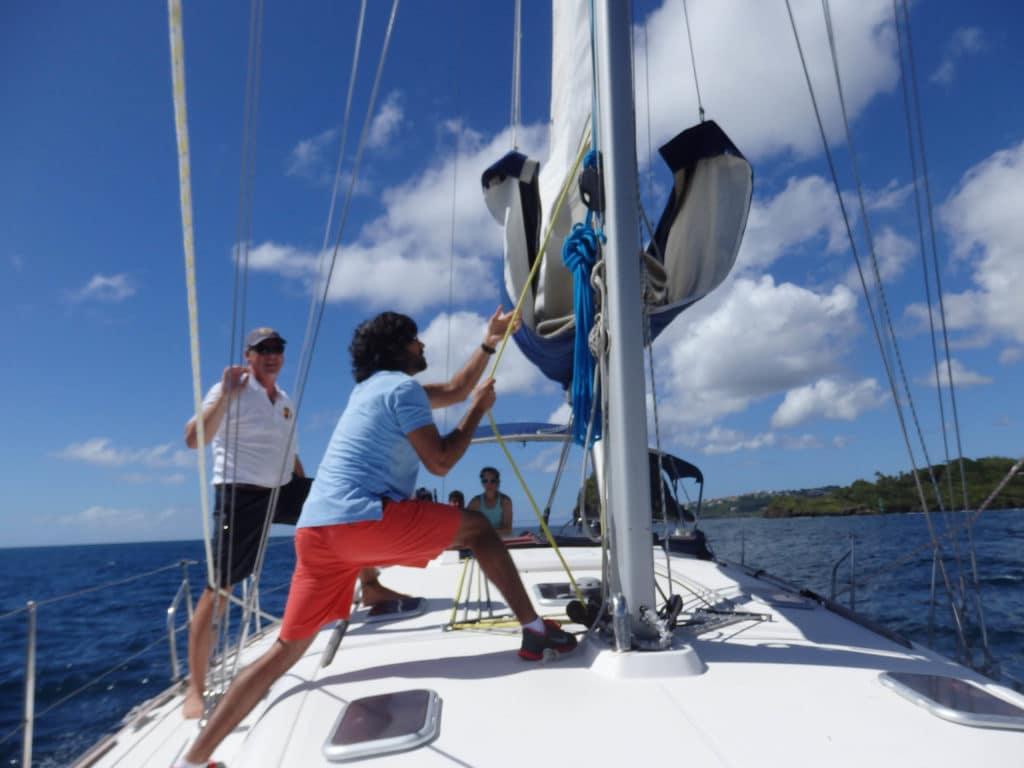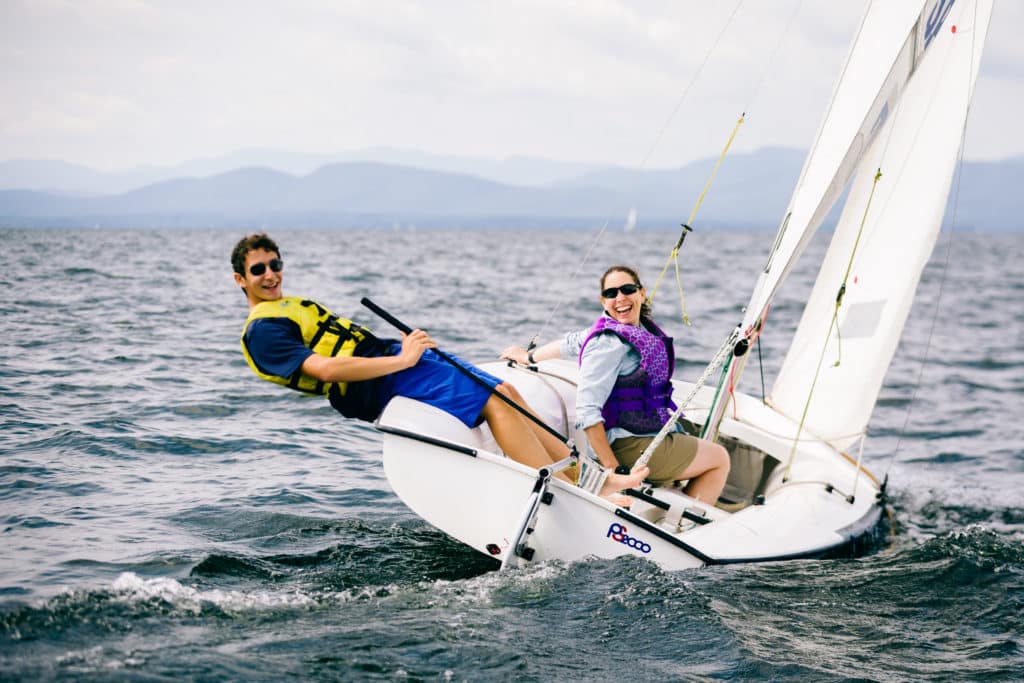
It’s been said that sailing is a skill that can take five minutes to learn and a lifetime to perfect. This is the appeal for many sailors; there is always room for improvement and a new trick to master. For beginners, however, the learning curve can seem steep. Fortunately, there are plenty of ways to gain the knowledge and experience necessary to start sailing on your local waters, head out on your first bareboat charter, or even make an offshore passage.
Where to Begin?
If you are a newcomer to the world of sailing, you may be wondering about the vocabulary (Ready about! Hard alee!) or what gear you might need for a day on the water. It’s a good idea to familiarize yourself with some sailing basics before your first class, either by checking out one of the many books on the subject (The Annapolis Book of Seamanship by John Rousmaniere is an excellent place to start, and The Complete Sailor by David Seidman is concise and well illustrated) or through an online course. The American Sailing Association (www.asa.com) has a free online class called Your First Sail, which introduces basic terminology, the fundamentals of how a sailboat works, and some common commands. Offshore Sailing School (www.offshoresailing.com), which has locations in New York, Florida and the British Virgin Islands, offers an online course as well that not only covers the basics, but also goes over anchoring, navigation and docking techniques. NauticEd (www.nauticed.org) has a full sailing curriculum online, and once students complete a course, they’re referred to a local sailing school for practical training. The company also has fun sailing games and apps to reinforce what you’ve learned.
If you’d like to go further than an online course and get your feet wet, so to speak, check out your local sailboat show. Sail America (222.sailamerica.com) hosts Discover Sailing pavilions at several in-water boat shows around the country, which give visitors the opportunity to go for a sail. In an effort to expose as many people to sailing as possible, Annapolis Boat Shows (annapolisboatshows.com), which runs the Annapolis Spring Sailboat Show and the massive U.S. Sailboat Show in the fall, has created a hands-on seminar designed for beginning sailors. Participants in the First Sail Workshop learn the basics of sailing in a 45-minute classroom session, immediately followed by 90 minutes on the water with SailTime and ASA instructors aboard a Beneteau First 22, an easy-to-master training boat. Once you feel like you at least know port from starboard, options abound to continue your sailing education and can fit a variety of budgets, locations and time commitments.
Keeping It Local
You can find community sailing centers throughout the country, from busy downtown Boston to a reservoir in landlocked Boulder, Colorado. Community sailing centers typically offer lessons for adults and kids, and members often have access to sailboat rentals. By staying with a local center, you’ll likely save money and be able to find a schedule that works for you.
What makes community sailing centers different from traditional sailing schools is that they are, for the most part, classified as nonprofits, and most have a mission that focuses on accessibility and affordability. “Boston Community Boating takes seriously the ability to make our programs accessible for anyone,” says Charlie Zechel, BCB executive director. Like many community sailing centers, Boston Community Boating, located on the banks of the Charles River, offers a variety of programs, including sailing lessons for adults that can fit into a busy work schedule, summer camps for kids, and a universal access program for disabled sailors.
“The best part of community sailing is that people of all ages, abilities and backgrounds are welcome to participate,” says Jen Guimaraes, associate director of the Community Sailing Center in Burlington, Vermont. “You just need to be willing to challenge yourself.”

Sailing Schools
Liveaboard classes, day classes, learning vacations, racing clinics — the variety of sailing education opportunities available means you can tailor your experience to your goals. Most sailing schools in the U.S. base their curriculum on standards set by either US Sailing or ASA, and both organizations offer a certification process.
Offshore Sailing School is one of the largest learn-to-sail organizations in the country. Doris and Steve Colgate have been at the helm of Offshore for more than 50 years, and in that time, they have refined the school’s methods and US Sailing-based curriculum. Doris says the most popular course they offer these days is Fast Track to Cruising, which includes two days on a Colgate 26, then five days on a 43- to 50-foot monohull or catamaran. “The cruising portion of the course can be done while living aboard and learning while moving from port to port, or [while] staying ashore at night and sailing during the day, but returning to the same place each night, which affords more docking practice,” Doris says.
For those looking to improve their performance under sail, whether by racing around the buoys or cruising down the coast, both Offshore Sailing and J World Sailing School, which has bases in Annapolis, San Diego, San Francisco and Puerto Vallarta, Mexico, offer courses that can help. For example, J World’s performance-cruising course covers topics including advanced sail trim and spinnaker skills, as well as navigation and onboard systems.
Go Farther
“ASA has been on a mission to bridge the gap between sailing lessons and the sailing lifestyle for some time,” says ASA president Cindy Shabes. To this end, the organization offers sailing flotillas in popular cruising hot spots. The flotillas, which are hosted by ASA schools around the world, accept sailors of all levels who want to have a great time and gain skills and experience. Flotillas consist of a lead boat, with someone on board who is an expert in the local waters, and a fleet of charter boats, all on a shared itinerary. Even if you’re an experienced captain, participating in a flotilla is a great way to become familiar with a new cruising ground, particularly if it has challenging sailing conditions or a culture or language you’re not familiar with. Locations that ASA has lined up for 2016 include Greece, Croatia and the Balearic Islands.
If you’re crunched for time and can’t decide between a vacation somewhere warm or sailing courses, consider doing both at once! There are sailing schools in Florida, California and the Caribbean that combine the fun of a charter vacation with the opportunity for private lessons and certifications during your charter. For example, Sail Caribe, based in Puerto Rico, offers learn-to-sail packages that include four ASA certifications during your weeklong charter.
Perhaps you’ve done some sailing locally, taken a cruise down the coast, or even have a few Caribbean bareboat charters in your logbook. If you’re looking to go to the next level, such as through an offshore passage, there are courses that can get you there. Both ASA and US Sailing offer certifications for offshore passagemaking. The courses typically involve a weeklong adventure on a cruising boat, and students participate in everything from passage planning to watch standing and emergency procedures. Modern Sailing School, an ASA-based program in Sausalito, California, has provided students with the opportunity to experience offshore passagemaking for three decades, and currently offers ASA 108 certification through a weeklong class that includes a 72-hour ocean passage. “I liked the idea of getting a taste of true bluewater cruising in a supported environment with an experienced instructor,” says Leigh Hunt, owner of Modern Sailing, who began his sailing career as one of its students. “It definitely was a confidence builder, and it did help me feel more comfortable moving on to larger passages.”
Jen Brett is CW’s senior editor.








